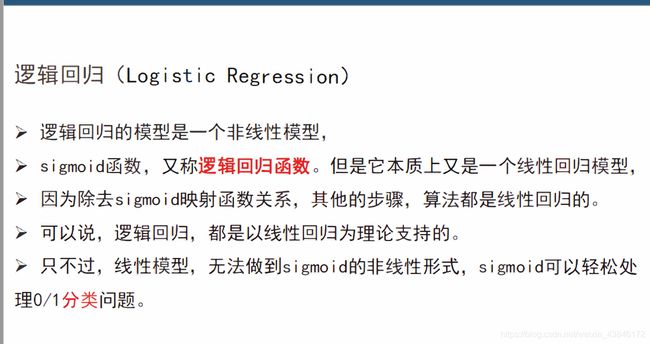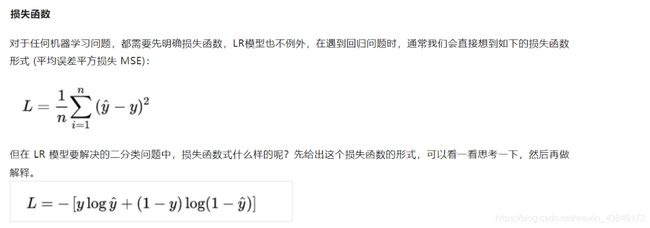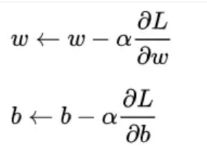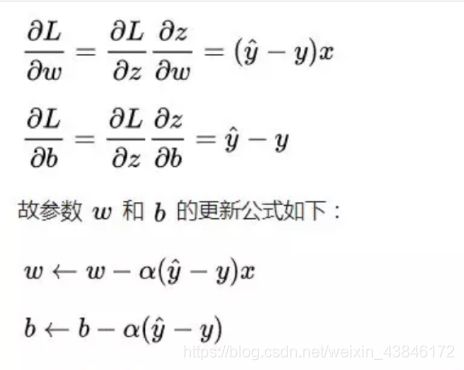机器学习:对数几率回归(逻辑回归)代码实现
机器学习:对数几率回归(逻辑回归)代码实现
- 相关知识
- 逻辑回归(Logistic Regression)
- 相关代码如下
- 运行结果如下:
相关知识
逻辑回归(Logistic Regression)
相关代码如下
#!/usr/bin/env python
# coding: utf-8
import numpy as np
class LogisticRegression(object):
def __init__(self,learning_rate=0.1,max_iter=100,seed=None):#学习率,循环次数,随机种子
self.seed = seed
self.lr = learning_rate
self.max_iter = max_iter
def fit(self,x,y):
np.random.seed(self.seed)
self.w = np.random.normal(loc=0.0, scale=1.0, size=x.shape[1])#.shape[1] 第二维的大小
self.b = np.random.normal(loc=0.0, scale=1.0)#通过normal(正态分布)为w,b 赋初值
self.x = x
self.y = y
for i in range(self.max_iter):
self._update_step()
def _sigmoid(self,z):#sigmoid函数
return 1.0 / (1.0 + np.exp(-z))
def _f(self,x,w,b):
z = x.dot(w) + b
return self._sigmoid(z)
def predict_proba(self, x=None):
if x is None:
x = self.x
y_pred = self._f(x, self.w, self.b)
return y_pred
def predict(self, x=None):
if x is None:
x = self.x
y_pred_proba = self._f(x, self.w, self.b)
y_pred = np.array([0 if y_pred_proba[i] < 0.5 else 1 for i in range(len(y_pred_proba))])
return y_pred
def score(self, y_true=None, y_pred=None):
if y_true is None or y_pred is None:
y_true = self.y
y_pred = self.predict()
acc = np.mean([1 if y_true[i] == y_pred[i] else 0 for i in range(len(y_true))])
return acc
def loss(self, y_true=None, y_pred_proba=None): #使用对数损失
if y_true is None or y_pred_proba is None:
y_true = self.y
y_pred_proba = self.predict_proba()
return np.mean(-1.0 * (y_true * np.log(y_pred_proba) + (1.0 - y_true) * np.log(1.0 - y_pred_proba)))
def _calc_gradient(self):
y_pred = self.predict()
d_w = (y_pred - self.y).dot(self.x) / len(self.y)#L对w求导
d_b = np.mean(y_pred - self.y)#L对b求导
return d_w, d_b
def _update_step(self):
d_w, d_b = self._calc_gradient()
#梯度下降
self.w = self.w - self.lr * d_w
self.b = self.b - self.lr * d_b
return self.w, self.b
import numpy as np
def generate_data(seed):
np.random.seed(seed)
#负样例
data_size_1 = 300
x1_1 = np.random.normal(loc=5.0, scale=1.0, size=data_size_1)
x2_1 = np.random.normal(loc=4.0, scale=1.0, size=data_size_1)
y_1 = [0 for _ in range(data_size_1)]
#正样例
data_size_2 = 400
x1_2 = np.random.normal(loc=10.0, scale=2.0, size=data_size_2)
x2_2 = np.random.normal(loc=8.0, scale=2.0, size=data_size_2)
y_2 = [1 for _ in range(data_size_2)]
#连接
x1 = np.concatenate((x1_1, x1_2), axis=0)
x2 = np.concatenate((x2_1, x2_2), axis=0)
#沿着水平方向将数组堆叠起来,构成二维向量
x = np.hstack((x1.reshape(-1,1), x2.reshape(-1,1)))
y = np.concatenate((y_1, y_2), axis=0)
data_size_all = data_size_1+data_size_2
#打乱点的顺序
shuffled_index = np.random.permutation(data_size_all)
x = x[shuffled_index]
y = y[shuffled_index]
return x, y
def train_test_split(x, y):#划分训练集和测试集,37开
split_index = int(len(y)*0.7)
x_train = x[:split_index]
y_train = y[:split_index]
x_test = x[split_index:]
y_test = y[split_index:]
return x_train, y_train, x_test, y_test
import numpy as np
import matplotlib.pyplot as plt
x, y = generate_data(seed=272)
x_train, y_train, x_test, y_test = train_test_split(x, y)
#归一化
x_train = (x_train - np.min(x_train, axis=0)) / (np.max(x_train, axis=0) - np.min(x_train, axis=0))
x_test = (x_test - np.min(x_test, axis=0)) / (np.max(x_test, axis=0) - np.min(x_test, axis=0))
# Logistic regression classifier
clf = LogisticRegression(learning_rate=0.1, max_iter=500, seed=272)
clf.fit(x_train, y_train)
# plot the result
split_boundary_func = lambda x: (-clf.b - clf.w[0] * x) / clf.w[1]
xx = np.arange(0.1, 0.6, 0.1)
cValue = ['g','b']
plt.scatter(x_train[:,0], x_train[:,1], c=[cValue[i] for i in y_train], marker='.')
plt.plot(xx, split_boundary_func(xx), c='red')
plt.show()
# loss on test set
y_test_pred = clf.predict(x_test)
y_test_pred_proba = clf.predict_proba(x_test)
print(clf.score(y_test, y_test_pred))
print(clf.loss(y_test, y_test_pred_proba))
运行结果如下:
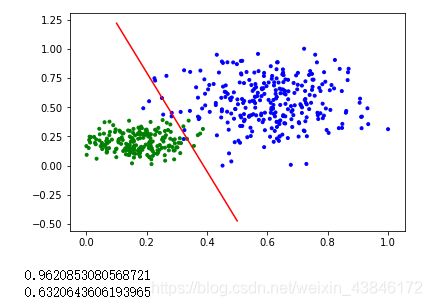
如有侵权,联系删除: [email protected]
